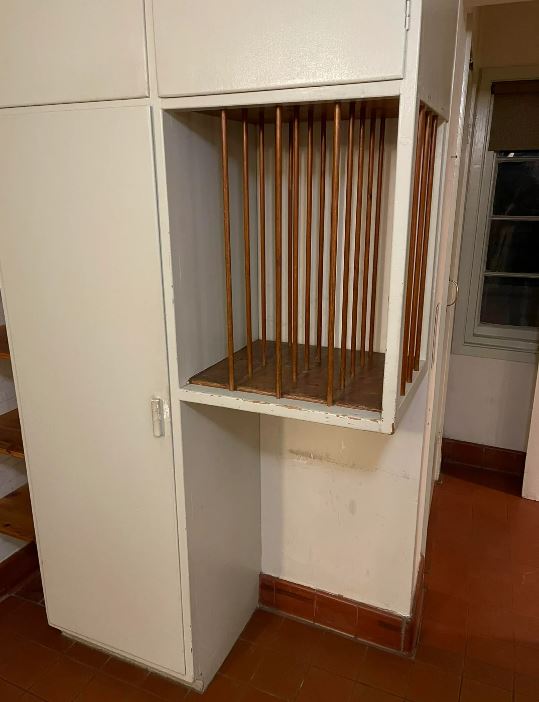In the heart of the Midlands in the United Kingdom, a mysterious wooden kitchen item has stirred curiosity across the internet, capturing the attention of those intrigued by forgotten tools and traditional craftsmanship. Shared on Reddit, this intriguing object stands out among typical kitchenware, appearing as a simple block of wood outfitted with movable pegs or dowels. But despite its unassuming appearance, it offers more questions than answers.

Its placement in a kitchen, prominently displayed rather than stored away, suggests it once served a meaningful role in food preparation or dining routines. These flexible pegs, arranged in a seemingly intentional pattern, hint at a functional purpose—perhaps for securing utensils, managing ingredients, or organizing tools during cooking. While its exact use remains unclear, its design implies that it was part of a culinary process that has long fallen out of everyday practice.
In modern times, where appliances do most of the heavy lifting in the kitchen, such an object feels like a relic from a world where cooking was a more hands-on, tactile experience. To uncover the true story behind this artifact, researchers would likely need to consult old records, including cookbooks, household inventories, or domestic history archives. Engaging with local historians from the Midlands, especially those focused on rural and culinary traditions, might shed light on how this item fit into daily life generations ago. Museums dedicated to the history of the home could also provide context, potentially housing similar objects or offering insights into how such tools were crafted and used. These institutions are treasure troves of knowledge about bygone lifestyles and may be the key to unlocking the mystery of this item’s past. Beyond its functional history, the object holds cultural and emotional value.
It serves as a physical link between modern life and the world of our ancestors. The care and thought put into its construction reflect a time when every item in the household was made with purpose, often by hand, and used over many years. As such, it becomes more than a cooking tool—it transforms into a narrative device, a silent witness to the rhythms and rituals of everyday life in another era. Its survival into the present day is a reminder that history isn’t always locked away in textbooks or museums; sometimes it sits quietly on a shelf, waiting to be noticed. In this case, the object speaks to the ingenuity and adaptability of past generations.
They found ways to make the most of their resources, often creating multi-functional tools that could evolve with their needs. This wooden item, though now obsolete, once played a small but vital role in the kitchen, and possibly in the lives of the family that owned it. Its design, while confusing to us today, likely made perfect sense to those who used it regularly. Holding such an item now invites reflection—not just on what it was, but on what it represents. It encourages us to think about the way our own lives are shaped by the tools we use and the traditions we keep. Even though technology has dramatically changed how we prepare food, the heart of the kitchen remains the same: a place of gathering, nourishment, and memory. That’s why finding a relic like this isn’t just a quirky discovery—it’s a meaningful encounter with history. It connects us to the broader human experience, reminding us that even the most ordinary objects can carry extraordinary stories. This enigmatic kitchen artifact from the Midlands may never reveal all its secrets, but its presence has already sparked conversations, inspired research, and bridged the gap between past and present. Whether it turns out to be a tool for bread making, cheese pressing, or something else entirely, its true legacy lies in the curiosity and connection it inspires across generations.





